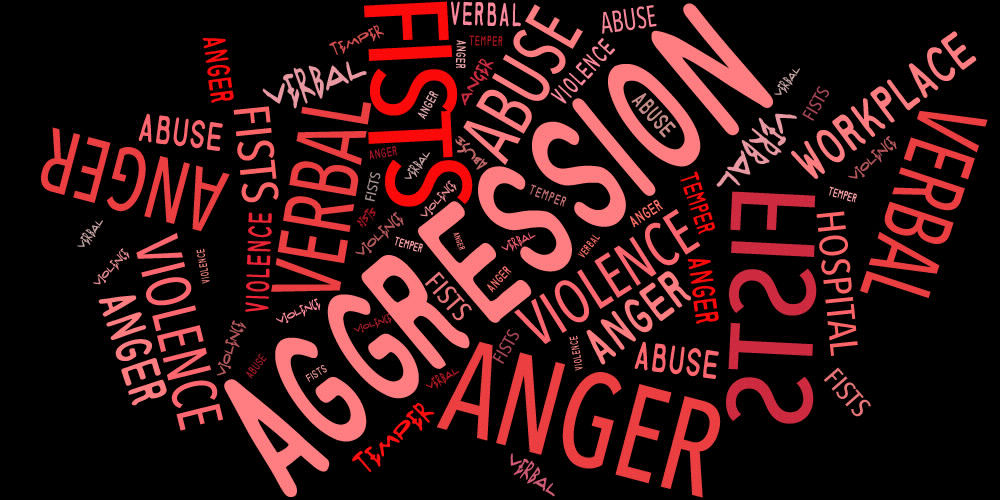hile screaming obscenities, John* threw his bedpan across the room. As hospital staff rushed to clean up the ensuing mess, John spit, scratched, and fought anyone within reach, successfully landing more than one punch on more than one caregiver. Down the hallway, his screams could be heard by other patients who wondered about their own safety.
This event occurred at University Hospital last year—and it serves as a textbook definition of workplace aggression. Similar behavior has become more and more common in hospital and clinic settings, ultimately affecting not only patient safety and quality of care but also the wellbeing of health care team members.
The impact of workplace aggression
The Joint Commission released a Sentinel Event Alert on April 17, 2018 to help health care organizations recognize and acknowledge workplace aggression. The alert also highlighted key findings:
- The American Nurses Association’s most recent Health Risk Appraisal found that 25% of nurses reported being physically assaulted by a patient or a family member—and only 50% of those assaults were reported
- A 2017 report from the International Association for Healthcare Security & Safety found that health care workers are four times more likely to be exposed to workplace aggression than workers in private industries
- According to OSHA, 75% of workplace assaults reported annually occur in health care and social service settings
In 2017, University of Utah Health saw an increase in safety event filings about patients or visitors demonstrating physical and verbal aggression, incivility, or bullying interactions with caregivers. A well-established system exists to de-escalate aggression in behavioral health settings like University Neuropsychiatric institute and 5 West, an adult inpatient unit at University Hospital. Less focus, however, has historically been placed on the availability of de-escalation resources throughout the rest of the organization.
How we’re tackling workplace aggression
A Behavioral Emergency Response Team, or BERT, will focus on the de-escalation of behavioral events occurring throughout the system, including ambulatory settings. Similar to the current RRT (Rapid Response Team), this new BERT team will consist of providers, staff, and security, all of whom are trained in the use of non-violent de-escalation techniques to ensure the safety of our patients, visitors, and staff. For the latest information on the BERT team, click here.
What you can do to help
Undoubtedly, most University of Utah Health departments, units, divisions, and clinics have a story to tell about a patient displaying aggressive or violent behavior toward staff. However, most health care workers under-report workplace aggression because they think such conditions must be accepted as “part of the job.” Or perhaps they feel that reporting is inconvenient. This reluctance to report events puts health care workers as well as patients and visitors at risk, while speaking up can lead to improvement and change. If you experience workplace aggression, say something by clicking here to file an RL.
* Name and account have been changed to protect patient and staff privacy.
Patient Safety at U of U Health
This article is excerpted from Patient Safety’s inaugural Safety News newsletter, which communicates important safety updates, education opportunities, current safety issues, and accreditation readiness needs. The Patient Safety department believes that championing the right processes and environments can incrementally improve safety, reflecting University of Utah Health’s mission to strengthen safety culture for patients, visitors, students, and staff. For more information on Patient Safety, click here. To report a safety event, click here.
Reposted with permission from Connie Phelps, MSN, RN and the Patient Safety Department. This post originally appeared in the Patient Safety Newsletter on April 17, 2018 on Pulse.
Connie Phelps
Health care is full of high emotion—especially right now. Thankfully, there’s a simple framework we can follow to de-escalate with compassion. Hospitalist and UACT co-director Claire Ciarkowski introduces NURSE: a simple mnemonic for responding with empathy.
Terry Tempest Williams is a Utah native, writer, naturalist, activist, educator—and patient. Here, Terry shares the many ways artists and authors are responding to the full range of emotions of life during COVID-19.
The best stories move us deeply, striking an emotional and inspiring chord. Huntsman Cancer Institute director of nursing Sue Childress shared the following essay, first composed for a Huntsman writing group, and we loved the way it tied intimate insights gathered at the bedside with the positive transformation Sue was lucky to witness outside the hospital. Plus, you can’t go wrong with a pun as strong as “Freudian Slippers.”
